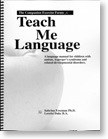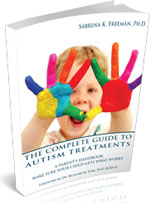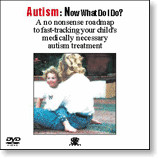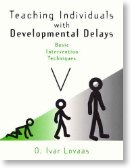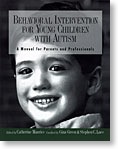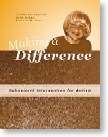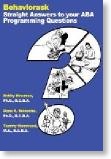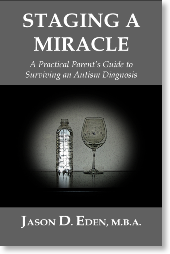Computer Data Tracking for ABA Programs
08/09/12 19:14 Filed in: autism

With the computer revolution, all kinds of programs were introduced and industrious parents created companies to sell improved ways to take data using a computer or iphone. Just recently a parent who follows the Autism Pundit blog sent me a link to download, free of charge, software that allows ABA data to be computerized and developed to replace paper and binders with a laptop. What is new about this computer program is it allows ABA teams to build data sheets/programs of their choice, and video programming is one of its main strengths.
I haven’t used this software yet, but for those of you who are still using a pencil and paper for all your data collection, here’s an opportunity to possibly make your life a little bit easier! For anyone who has had experience with the program, please send me a note to share your thoughts.
Speech and Language Pathologists are the first responders for autism
27/07/12 11:17 Filed in: autism | Asperger's Syndrome

SLPs are often the first professionals to see a child with autism because the child is not developing language in a typically developing fashion. SLPs often recognize autism immediately due to the symptoms of the disorder that include echolalia, delayed echolalia, lack of joint attention and general lack of communication. Due to their expertise, SLPs can be crucially important in getting parents to act quickly on early intervention. However, SLPs frequently find themselves in a quandary: they know something is amiss but they are not diagnosticians. Unless they are credentialed in diagnosing childhood disorders, they are not allowed to render a diagnosis of autism even when red lights are flashing.
I have seen this situation all too often. It’s so common that after the diagnosis, parents actually complain about the fact that no one – including the SLP who first worked with their child – ever told them that their child may be afflicted with autism. I’ve heard many parents say, "if I could only get that lost year back."
I would like to strongly encourage SLPs to let the parents know if there are greater concerns about the child's language development and suggest that the child may benefit from an intensive treatment program. If the SLP is allowed to use the "autism" word, they should! If that’s impermissible, then they should encourage the parent to visit a local developmental pediatrician who is known to diagnose autism quickly, and accurately. In order to find that pediatrician, I would contact the local Families for Early Autism Treatment (FEAT) or ABA parent group in the area, and ask for the name of the best diagnostician in town.
It is one thing to have this information and quite another to communicate the information in an effective manner. To that end, I would suggest the following words:
"I am very concerned about Johnny, and Dr. Jones is a pediatrician who will very quickly be able to tell you if you need to have your child in an intensive treatment program for this language delay. Dr. Jones will have excellent advice about what we need to do to help Johnny. Obviously I can work on your child's language and communication skills, but I want to make sure that we give your child the best start in life and I want to make sure that he reaches his full potential. The way to do this is through an assessment by Dr. Jones and possibly an intensive treatment program.”
I would also source the name of the best local psychologist who can diagnose the child. The local FEAT or ABA parent group should have the name of this professional. In addition, a good SLP should find out who in the area is a Board Certified Behavior Analyst (BCBA) who provides Intensive Behavioral Treatment (IBT) for autism. Armed with this knowledge, the SLP’s next step is to ask the parent group how parents in the area are funding the treatment. Depending upon jurisdiction, there may be laws protecting the child’s rights to treatment. The local FEAT type group will have this information.
Here’s the list of the steps an SLP can take when he or she is working with a child they suspect may have undiagnosed autism:
1) Find the professionals in your area who a) can provide a quick and accurate diagnosis e.g., pediatricians & psychologists, and b) are excellent practitioners in intensive behavioral treatment (e.g. BCBA)
2) Parent Group: a) find the parent group in your area that supports ABA (FEAT or FEAT-like organizations), and b) find out where and when they meet.
3) Sleuth out the funding agencies or insurance plans that pay for the treatment and find out how parents can best access these funds.
4) Create a New Parent Packet for information to give to these parents (or use the one that the local FEAT group provides)
Here are some tips to think about when an SLP is delivering the message:
- Stay on topic
- Don’t let immigrant status, poverty or lack of resources get in the way of helping these families access behavioral treatment programs.
If these folks have limited financial resources and are on a services wait list for several months, I would strongly recommend that they contact the local ABA parent group, which is free. There they will meet other parents who may help them find a way to get an earlier diagnosis.
- Ignore SLP colleagues who claim that everyone needs to take their own journey to come to the realization that their child has autism.
In short, you as an SLP have the power – and 1st responder insight – to speed up the diagnostic process considerably. Use your power for good!
Memo to Huffington Post: autism treatment is about kids, not parents
10/04/12 19:10 Filed in: autism | Asperger's Syndrome
In recognition of Autism Awareness month, the Huffington Post printed an article called 10 Things To Do After an Autism Diagnosis. The author -- Hannah Brown -- gives advice to parents on what they should do after the autism diagnosis bombshell is dropped on them. Although I applaud the helpful sentiment, ninety percent of the advice given by Brown was to parents about their own mental health and coping mechanisms and not about how to help their child.
To illustrate, although taking valium may help a parent cope, and making sure that one’s name is on all joint assets may be helpful in the event a spouse leaves the relationship, these things do nothing for the child. However, if the parent takes effective steps to improve their child’s situation, valium will be needed less and the marriage will likely be more harmonious. Life would be less stressful and something that together, as a team, the family unit can better withstand. Here are my “10 Things to Do After the Diagnosis”:
1) Find a parent group in your area that supports science-based treatment which is, currently, Early Intensive Behavioral Treatment (EIBI) based on the principles of Applied Behavior Analysis (ABA).
2) Join the Me-List on FACEBOOK and the Me-List on Yahoo. Both these groups are comprised of parents worldwide who have treatment teams up and running.
3) Find out if you live in a region where insurance companies are required to provide coverage for EIBI autism treatment. Find how parents in your region are funding their children’s treatment programs.
4) Source a list of Behavioral Consultants in your region with expertise in EIBI. If you don’t have any local expertise, here are a few national companies.
5) Phone the Behavioral Consultants you find and have them provide three references from parents who use their services. If they won’t give you references, go to the next consultant on your list. There is a certification board for this group of professionals and you can find them in your search, via zip code; however, make sure that their expertise is autism.
6) Once you hire the Behavioral Consultant, start recruiting for your treatment team.
7) Set up a training session for your team and start your program. The first couple of weeks are somewhat of a shock, but then you’ll get into a routine.
8) Start reading the right books. I have a list on the Autism Pundit bookshelf.
9) Sign-up for the Association for Science in Autism Treatment’s Newsletter and get savvy about how to differentiate science from quackery!
10) Breathe. If you follow the above steps, your child will reach his or her potential, and you have no idea how great that potential may be!
As a parent who has been in the autism universe for over two decades, I’m of the view that these steps are going to get you where you need to go. For now, ignore all the other noise out there. Your job is to get your child into a treatment program A.S.A.P. Nothing else will matter until your child has access to high quality treatment.
To illustrate, although taking valium may help a parent cope, and making sure that one’s name is on all joint assets may be helpful in the event a spouse leaves the relationship, these things do nothing for the child. However, if the parent takes effective steps to improve their child’s situation, valium will be needed less and the marriage will likely be more harmonious. Life would be less stressful and something that together, as a team, the family unit can better withstand. Here are my “10 Things to Do After the Diagnosis”:
1) Find a parent group in your area that supports science-based treatment which is, currently, Early Intensive Behavioral Treatment (EIBI) based on the principles of Applied Behavior Analysis (ABA).
2) Join the Me-List on FACEBOOK and the Me-List on Yahoo. Both these groups are comprised of parents worldwide who have treatment teams up and running.
3) Find out if you live in a region where insurance companies are required to provide coverage for EIBI autism treatment. Find how parents in your region are funding their children’s treatment programs.
4) Source a list of Behavioral Consultants in your region with expertise in EIBI. If you don’t have any local expertise, here are a few national companies.
5) Phone the Behavioral Consultants you find and have them provide three references from parents who use their services. If they won’t give you references, go to the next consultant on your list. There is a certification board for this group of professionals and you can find them in your search, via zip code; however, make sure that their expertise is autism.
6) Once you hire the Behavioral Consultant, start recruiting for your treatment team.
7) Set up a training session for your team and start your program. The first couple of weeks are somewhat of a shock, but then you’ll get into a routine.
8) Start reading the right books. I have a list on the Autism Pundit bookshelf.
9) Sign-up for the Association for Science in Autism Treatment’s Newsletter and get savvy about how to differentiate science from quackery!
10) Breathe. If you follow the above steps, your child will reach his or her potential, and you have no idea how great that potential may be!
As a parent who has been in the autism universe for over two decades, I’m of the view that these steps are going to get you where you need to go. For now, ignore all the other noise out there. Your job is to get your child into a treatment program A.S.A.P. Nothing else will matter until your child has access to high quality treatment.
Staging a Miracle: An Interview with Jason Eden
02/09/11 15:22 Filed in: autism | Asperger's Syndrome
I had the privilege of speaking with Jason Eden, the author of Staging a Miracle: A Practical Parent’s Guide to Surviving an Autism Diagnosis. In this interview, Jason discusses his journey from diagnosis to treatment and ultimate success with his son. Read more...
We're Aware Already!
31/08/11 09:30 Filed in: autism | Asperger's Syndrome
Year after year, we keep hearing the same message: Autism Awareness, Autism Awareness... I think that at this point, we are already aware and it is time to tell people what to do with their awareness! Read more...
An Inconvenient Truth for Autism film: Third trailer available for viewing
28/08/11 19:58 Filed in: autism | Asperger's Syndrome
The organization, Medicare for Autism Now has just released its third trailer for the film Medicare’s Orphans. Watch the trailer...



